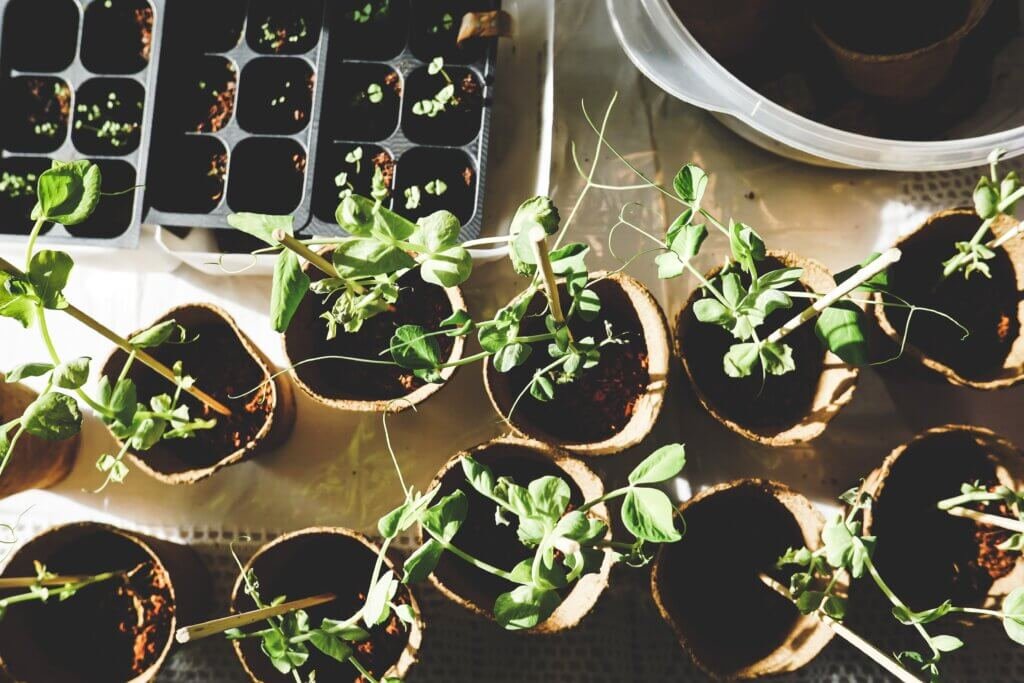In this article, you will learn all the essential tips and techniques on how to effectively prune and maintain plants in your urban garden. Whether you’re a seasoned gardener or just starting out, keeping your plants healthy and thriving is crucial. We will explore the importance of pruning, the proper tools to use, and the best practices for maintaining a beautiful and thriving urban garden. With these easy-to-follow guidelines, you’ll be able to transform your garden into a lush oasis right in the heart of the city. So, put on your gardening gloves and let’s get started!
Choosing the Right Plants
Consider the Size and Growth Habit
When choosing plants for your urban garden, it’s important to consider the size and growth habit of each plant. Determine how much space you have available and choose plants that will fit well within that space. It’s also important to consider how the plant will grow over time. Some plants have a columnar growth habit, while others spread out more horizontally. By considering these factors, you can ensure that your plants will have enough room to grow and won’t become overcrowded.
Select Local and Native Plants
Choosing local and native plants for your urban garden offers numerous benefits. These plants are well-adapted to the local climate and soil conditions, making them more likely to thrive in your garden. They also provide important habitat and food sources for local wildlife, such as birds and butterflies. Additionally, local and native plants often require less water and maintenance, making them a sustainable and eco-friendly choice for urban gardens.
Choose Low-maintenance Varieties
Maintaining an urban garden can be time-consuming, especially if you have a busy schedule. To make your gardening experience more manageable, choose low-maintenance varieties of plants. These plants typically require less water, fertilizer, and pruning compared to high-maintenance varieties. Look for plants that are drought-tolerant, disease-resistant, and have compact growth habits. By choosing low-maintenance varieties, you can spend less time on upkeep and more time enjoying your urban garden.
Basic Pruning Techniques
Understand Plant Growth Patterns
Before you start pruning your plants, it’s important to understand their growth patterns. Some plants have a single stem with lateral branches, while others have multiple stems arising from the base. By familiarizing yourself with the growth patterns of your plants, you can better determine where to make your pruning cuts for optimal growth and appearance.
Identify Dead or Diseased Branches
One of the main purposes of pruning is to remove any dead or diseased branches from your plants. Dead branches can be easily identified by their lack of foliage and brittle appearance. Diseased branches may exhibit discoloration, spots, or other signs of illness. By removing these branches, you can prevent the spread of disease and allow your plants to allocate their resources to healthy growth.
Remove Crossing or Rubbing Branches
When pruning, it’s important to identify and remove any crossing or rubbing branches. These branches can cause damage to the plant, create wounds that allow pests and disease to enter, and create an unattractive appearance. By removing crossing or rubbing branches, you can improve the overall structure and appearance of your plants.
Create an Open Center Structure
For certain plants, such as fruit trees, creating an open center structure can be beneficial. This involves removing the central leader and selecting several lateral branches to serve as the main framework of the plant. An open center structure allows for better air circulation and sunlight penetration, reducing the risk of diseases and promoting better overall growth and fruit production.

Tools for Pruning
Hand Pruners
Hand pruners are essential tools for any gardener. They are used for cutting small branches and stems with precision. Look for pruners with a bypass blade design, as they provide clean and precise cuts. Hand pruners are great for shaping plants, removing dead flower heads, and maintaining the overall appearance of your garden.
Loppers
Loppers are larger and more powerful pruning tools that are used for cutting thicker branches. They have long handles to provide extra leverage and can cut branches up to 1-1.5 inches in diameter. Loppers are great for pruning small trees, shrubs, and thick woody stems that hand pruners may not be able to handle.
Pruning Saws
Pruning saws are designed specifically for cutting larger branches and woody stems. They have sharp, serrated blades that make cutting through thick wood easier and more efficient. Pruning saws are essential for larger pruning jobs, such as removing dead branches from trees or shaping overgrown shrubs.
Hedge Shears
Hedge shears are used for trimming and shaping hedges and shrubs with softer, leafy growth. They have long, straight blades that can cut through multiple branches at once. Hedge shears are great for maintaining the shape and size of your plants, but should not be used for cutting thicker branches.
Pole Pruners
Pole pruners are ideal for pruning tall trees and shrubs without the need for a ladder. They consist of a long pole with a cutting head attached to the end. Pole pruners allow you to reach and cut branches that are high above ground level. They are essential for maintaining the height and shape of tall plants in your urban garden.
Timing and Frequency
Prune in the Correct Season
The timing of pruning can vary depending on the type of plant. In general, it is best to prune deciduous plants in late winter or early spring before new growth begins. This allows the plant to allocate its resources towards new growth and promotes a healthier and fuller appearance. Evergreen plants can be pruned throughout the year, but it is usually best to avoid pruning during extreme temperatures or periods of drought.
Know When to Prune Flowering Plants
When pruning flowering plants, it is important to consider their bloom time. Some plants bloom on old wood, meaning they produce flowers on branches that grew the previous year. These plants should be pruned after they have finished blooming to avoid removing potential flower buds. Other plants bloom on new wood, meaning they produce flowers on branches that grow during the current year. These plants can be pruned in late winter or early spring before new growth begins.
Establish a Regular Pruning Schedule
Establishing a regular pruning schedule can help you stay on top of maintaining your urban garden. By pruning plants on a regular basis, you can promote healthier growth, prevent overcrowding, and maintain the desired shape and size of your plants. Develop a pruning calendar and stick to it, taking into account the specific needs of each plant in your garden.

Pruning Techniques for Different Plants
Pruning Trees
Pruning trees is essential for maintaining their health and appearance. When pruning trees, start by removing any dead, damaged, or diseased branches. Next, remove any crossing or rubbing branches to prevent future problems. Consider the overall structure of the tree and remove any branches that are growing towards the center or interfering with other branches. Always use proper pruning techniques, such as making clean and angled cuts just outside the branch collar.
Pruning Shrubs
Pruning shrubs can help maintain their shape, promote healthier growth, and encourage more flowers or fruits. Start by removing any dead or diseased branches. Next, selectively remove branches to shape the shrub and promote better air circulation. Pay attention to how the shrub naturally grows and avoid cutting back into old wood unless necessary. Use proper pruning techniques, such as cutting just above a bud or lateral branch.
Pruning Perennials
Pruning perennials can help maintain their appearance, promote better blooming, and prevent overcrowding. After the growing season, cut back the stems of perennial plants to a few inches above ground level. This helps rejuvenate the plant and encourages new growth in the following season. However, some perennials may benefit from leaving the foliage intact during the winter to provide protection. Always research the specific needs of each perennial before pruning.
Pruning Vines
Pruning vines is important for controlling their growth, maintaining their appearance, and promoting better flowering or fruit production. For some vines, such as clematis, prune by removing any dead or damaged stems in early spring. For others, such as grapevines, prune to remove excessive growth and train the vine along a support structure. Always research the specific pruning needs of each vine to ensure proper care and maintenance.
Structural Pruning
Encourage Proper Branch Distribution
Structural pruning is aimed at creating a well-balanced and strong framework for trees and shrubs. To encourage proper branch distribution, start pruning at a young age. Select the strongest, well-spaced branches to be the main framework of the plant and remove competing branches. This will prevent overcrowding, promote better airflow, and reduce the risk of branches breaking under heavy loads.
Promote Stronger Branches
Pruning can help promote stronger branches by removing weak or competing branches. Thin out the canopy by removing crossing or rubbing branches that can weaken the structure of the plant. This allows the remaining branches to receive more sunlight and nutrients, resulting in stronger overall growth and a more resilient plant.
Avoid Overcrowding and Imbalance
Overcrowding and imbalance can lead to a variety of problems in your urban garden. Plants that are too crowded may not receive adequate sunlight, nutrients, and airflow, leading to weak and unhealthy growth. Pruning can help alleviate overcrowding by selectively removing branches to create more space. Additionally, pruning can help restore balance to plants that have become lopsided or unbalanced in their growth.

Pruning Fruit Trees
Understand the Growth Habit of Fruit Trees
Pruning fruit trees is important for maintaining their health and maximizing fruit production. Understanding the growth habit of your fruit trees is essential for effective pruning. Some fruit trees have a central leader, where one main vertical stem dominates the tree’s growth. Others have an open center structure, with several main lateral branches forming the framework. Understanding the growth habit will help you choose the appropriate pruning techniques for your fruit trees.
Prune to Enhance Fruit Production
Pruning fruit trees can enhance fruit production by promoting better airflow, sunlight penetration, and fruit access. Start by removing any dead, damaged, or diseased branches. Next, selectively thin out the canopy to improve the penetration of sunlight and airflow. Remove any excessively vigorous branches that may shade out the fruit-bearing branches. Additionally, thinning out excess fruit can promote better fruit size and quality.
Train Young Trees for Proper Growth
When dealing with young fruit trees, it’s important to train them for proper growth and structure. Select a single, central leader or several well-spaced lateral branches to serve as the main framework of the tree. Remove any competing branches and consider the desired shape and size of the mature tree. Proper training during the early years will result in a stronger, healthier, and more productive fruit tree in the long run.
Maintaining Healthy Plants
Provide Adequate Watering
Proper watering is essential for maintaining healthy plants in your urban garden. Most plants require regular watering, especially during hot and dry periods. The amount of water needed will vary depending on the plant species, soil type, and weather conditions. Water deeply and thoroughly, allowing the water to penetrate the root zone. Avoid overwatering, as this can lead to root rot and other moisture-related issues.
Apply Fertilizer as Needed
Fertilizing your plants can provide them with essential nutrients for healthy growth. Choose a balanced fertilizer specifically formulated for the type of plants in your urban garden. Follow the instructions on the fertilizer package for proper application rates and timing. It’s important to note that over-fertilizing can be harmful to plants, so always apply fertilizer as directed and avoid excessive use.
Monitor for Pests and Diseases
Pests and diseases can quickly wreak havoc on your urban garden if left unchecked. Regularly inspect your plants for signs of pests, such as chewed leaves, discolored foliage, or insect presence. Treat pest infestations promptly using organic or chemical methods, depending on your preference and the severity of the infestation. Similarly, monitor for any signs of plant diseases, such as leaf spots or wilting. Remove and destroy any infected plant parts to prevent the spread of disease.
Mulch to Conserve Moisture
Mulching can help conserve moisture in your urban garden, reduce weed growth, and improve soil health. Apply a layer of organic mulch, such as wood chips or shredded leaves, around the base of your plants. This will help retain soil moisture, reduce the need for frequent watering, and provide insulation for plant roots. Additionally, mulch can help suppress weeds, which can compete with your plants for water and nutrients.

Managing Plant Size
Controlling Height and Spread
Managing the size of your plants is important for maintaining a well-manicured and orderly urban garden. Some plants naturally have a compact growth habit, while others can quickly become unruly and overgrown. Regular pruning can help control the height and spread of your plants. By selectively removing branches, you can shape your plants to fit in the space available and prevent them from encroaching on surrounding areas.
Renewal Pruning for Overgrown Plants
If your plants have become overgrown or have lost their shape, renewal pruning can help rejuvenate them. This involves cutting the plant back to near ground level, leaving only a few inches of growth. Renewal pruning is typically done during late winter or early spring before the plant begins to grow. After pruning, the plant will produce new growth from the base, resulting in a healthier, more compact, and better-looking plant.
Plant Divisions and Transplants
Plant divisions and transplants can also help manage the size of your plants. Some plants, such as ornamental grasses or clumping perennials, can be divided into smaller sections and replanted in different areas of your garden. This not only helps control their size but also allows you to create more plants for other parts of your urban garden. Similarly, transplanting plants to larger or more suitable areas can help accommodate their growth and prevent overcrowding.
Considerations for Small Spaces
Choose Compact Varieties
When gardening in small spaces, choosing compact varieties of plants is key. Look for plants that have a natural compact growth habit or are specifically bred for small gardens. These plants typically have shorter heights, narrower spreads, and require less pruning to maintain their size. Compact varieties are perfect for small urban gardens, as they allow you to maximize your space while still enjoying a diverse range of plants.
Vertical Gardening Techniques
Vertical gardening techniques can significantly increase your gardening space in small urban gardens. Consider utilizing trellises, arbors, or wall-mounted containers to grow climbing plants such as ivy, morning glory, or clematis. Vertical gardening not only adds visual interest to your garden but also maximizes your planting area by utilizing vertical surfaces that would otherwise go unused.
Utilize Containers
Containers are a versatile solution for gardening in small urban spaces. They allow you to grow plants in restricted areas, such as balconies or patios. Choose containers with adequate drainage holes and fill them with high-quality potting soil. Select plants that are suitable for container gardening, such as dwarf varieties or those with shallow root systems. Place the containers strategically to make the most of available sunlight and create an attractive display in your urban garden.
By following these tips on choosing the right plants, basic pruning techniques, tools for pruning, timing and frequency of pruning, pruning techniques for different plants, structural pruning, pruning fruit trees, maintaining healthy plants, managing plant size, and considerations for small spaces, you can properly prune and maintain your plants in an urban garden. Remember to approach pruning with care and consideration for the overall health and appearance of your plants, and enjoy the rewards of a well-maintained urban garden. Happy pruning!



